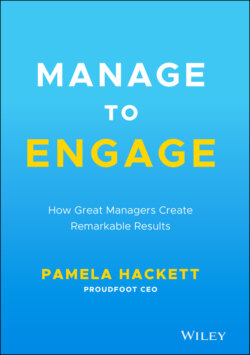Читать книгу Manage to Engage - Pamela Hackett - Страница 11
But What if They Could?
ОглавлениеThere is a way. Leaders often see engagement as the outcome rather than the launchpad to build stronger ecosystems and achieve results. Manage to Engage addresses this with simple concepts you will learn about like HeadsUp and the HeadsUp High Five (Presence, Vision, Tech Savvy, Coaching, and Influence), behavior models like active management, and the unique performance improvement tool that engages as much as it brings about improvement and change: 1.5.30.
These are the fundamental tools you'll find in this book, positioned in an engagement framework based on a new scorecard of 2 Fs and 7 Cs – the MI-9 triggers of engagement. Packed with tools and exercises to apply, the scorecard has you addressing performance improvement through the lens of engagement, and I hope energizes you to manage to engage.
But let's stop for a moment and think about where organizations were long before the COVID-19 crisis hit. Before the global financial crash of 2007–2008, we already had a crisis: a people crisis. Surveys the world over reported high levels of underengagement. In fact, almost two-thirds of most workforces around the world were in neutral at work, neither engaged nor disengaged. Then when financial panic set in, they clung to their positions out of necessity, not interest. A decade on, little had improved. We were relying on those same emotionally disconnected people to execute our business strategies. We knew this epidemic of discontent was hardly going to drive innovation in disrupted, highly competitive markets but we still had no solution.
Then a more literal epidemic hit: the COVID-19 pandemic. And the world changed again. This time on a massive global scale. Trust in leaders, business, and institutions was already at an all-time low as we entered the COVID-19 crisis. The virus gave trust an extra kick in the pants. And that neutral workforce either remained in neutral, disengaged, or if you were lucky, engaged to help save their organizations. Still others became essential workers – everyday bus and train drivers, delivery people, grocery store workers, and of course our health care workers. They all became heroes. The question we then needed to ask was, “How would we treat them postpandemic? Could we engage them for the long term to help build back better?”
